
views
Trapping Wild Quail
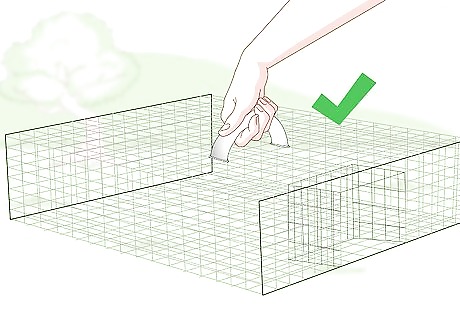
Get a quail trap or build your own. To make catching quail easy, purchase a basic trap. Funnel cage traps and net traps are humane. They don’t hurt the birds at all. These traps are also pretty simple to replicate on your own with a few basic supplies. For example, try building a basic box trap by installing a closed hinge door on top of a wooden box, then creating a small hole near the bottom. The birds walk into the hole and try to escape towards the light in the door.. Quail traps are available online and at some hunting or farm supply stores. For an easy net trap, try tying bird netting or fish netting to a bendable steel wire or strong posts. Plant the trap in the ground so the quail walk through the net and get tangled in it. Another simple trap you can try is a PVC pipe trap. For this trap, you need some pipes a little bigger than the quail and a bucket to place beneath them. The quail walk through the pipes and fall into the bucket.
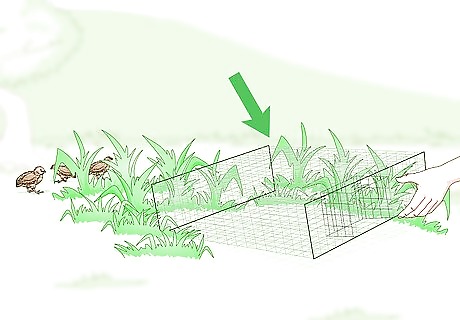
Place the trap in a location where quail gather. Look around for the quail before you set up your trap. They gather in flocks, so they aren’t too hard to spot. They live in wooded areas with lots of grass and brush to hide in. Set your trap up in an open meadow so you can keep an eye on it. Traps also work for catching escaped pet quail. Simply set the trap up near the quail’s hiding spot. If the quail escapes to nearby woods, set the trap up there.
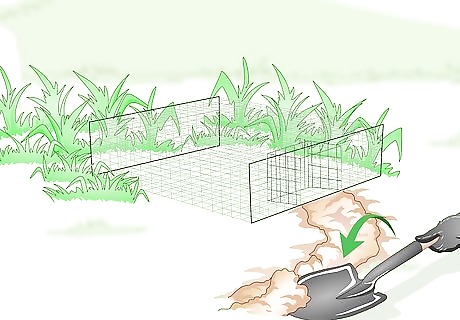
Dig a trench to guide the quail to the trap. Use a shovel to create a trail towards the trap. Make it about 12 in (30 cm) long. It doesn’t have to be deep. As long as it is lower than the ground around the trap, the quail will walk down the trail. Pile the dirt along the edges of the trail so the quail walks towards the trap. If you aren’t able to dig out the soil, find a different way to create the trail. You may be able to push aside some brush to form a natural trail. Alternatively, try stacking wood or other objects to form a makeshift trail. If you’re using a pipe trap, dig a hole at the opposite end of the pipe. Set a bucket in the hole, then cover it with mesh or netting. Make sure the netting is above the pipe rather than directly over the bucket. That way, the quail fall into the bucket but can’t fly out.

Bait the trench and trap with bird seed. Quail eat millet and cracked corn, which are components in most commercial seed mixes. Scatter the seed around the trench, then place a little bit inside of the trap. Spread more seed outside of the trench to draw in more curious quail. Scattering the seed as far as 20 ft (6.1 m) from the trap helps lure in quail. Spread the seed out so the quail have to walk towards the trap rather than stand in place and snack. Stop by a local pet store or wild bird supply store to get bait, or try mixing your own. Quail enjoy grains like wheat, corn, and sunflower seeds. Quail eat green plants, including lettuce, broccoli, and turnip greens. They also eat insects like ants, beetles, and larva. Scatter the bugs near your trap or put some in a clear container inside the trap to use them as bait.

Move the quail into a storage box after it enters the trap. Wait for the quail to make its way to the end of the trench. Eventually, it will walk right into the net, bucket, cage, or whatever else you set up to catch it. Gently lift the quail out of the trap and move it to a storage box until you are ready to release it. Quail traps are generally very small. Many of them hold 1 to 3 quail at a time. Plan on having a way to empty the trap, especially if you need to catch multiple birds. Check the trap often and keep a carrier cage nearby to transfer the caught quail to. If you’re using a cage trap, leave the quail in the cage unless you plan on setting up the trap again. Otherwise, move the quail to a mesh cage or a small box with air holes cut into it. Quail get stressed when they are left in storage boxes for too long. Storage boxes are meant to be temporary, so move the quail out as soon as you get the chance.
Catching Indoor Quail

Lock any other pets in a separate room away from the quail. Other animals tend to startle or even chase quail, so move them as far away from the loose bird as possible. Make the room comfortable for them, then lock the door to prevent them from escaping too. If you’re sure your quail won’t be able to get outside, you can let your pets outside. Make sure they will safe outside. Leash them if escaping is a concern, and give them plenty of water and shade if it’s hot out.

Close the doors of any other rooms. The goal is to trap the quail in a single room. That way, you aren’t chasing the quail as it runs laps around your home. Rooms with lots of crevasses, furniture, and other hiding spots are the most problematic, so make them off limits for now. To cut down on hiding spots, try to herd the quail into a small or empty room. Walk towards it or scatter some bird seed on the ground to lure it.

Block off any gaps, holes or hiding spots in the room. Expect the quail to run for these hiding spots to escape your grasp. Fill in these spots as much as possible. For example, block off the space around wardrobes, underneath desks, and behind cupboards. Try stuffing pillows, blankets, towels, books, and other items there. If the quail slips into a tight space, it can get stuck. You will have to physically move the object, which can be a little dangerous while the quail is behind it.
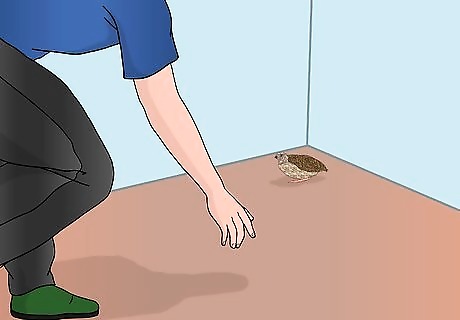
Walk slowly towards the quail to corner it. Try not to startle the quail. Don’t make any sudden movements. Quail fly straight up when they are frightened. It’s a natural instinct to escape predators in the wild, but unfortunately, it doesn’t work too well inside your home. A quail can seriously hurt itself by hitting its head on your ceiling. Treat injuries immediately. Try giving the bird some sugar water, then treat any wounds with a bird-safe antiseptic. Try using iodine antiseptic swabs to clean wounds.

Throw a blanket or towel on the quail to catch it. The cover stops the quail from flying or running away. Once you have quail covered, you won’t have any problems grabbing it. Gently pick it up to begin returning it to where it belongs. If the quail gets away, back off for a minute. Let it calm down, then try to corner it again.

Lead the quail to a pet carrier if you can’t cover it. Make sure the quail is bigger than the gaps in the carrier door, which are usually around ⁄2 in (1.3 cm) in size. Place the carrier in the room. To lead the quail to it, walk slowly towards the quail. Hold out your hands or a blanket to prevent the quail from running in the wrong direction. Close the door once the quail gets inside the carrier. Put the carrier in a spot you think the quail will head towards. Usually, picking a corner of the room is your best bet. Keep the space open so your quail doesn’t escape behind some furniture. Moving too quickly or suddenly spooks quail, causing them to fly. Take your time and don’t panic.

Hold the quail’s wings down firmly while it is out of the box or carrier. Cup the quail in your hands. Keep your palms over the quail’s back so it can’t flap its wings. If you threw a blanket over the quail, don’t even bother removing it. Take the quail to a box, a carrier, or its home before removing the blanket. Handle the quail gently. Don’t squeeze it or else you may harm it. To reduce the amount of handling needed, put the quail in a small box with a few breathing holes.
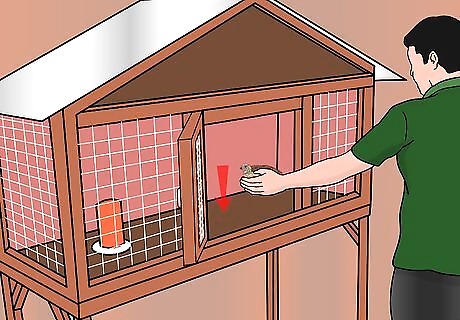
Return the quail to its cage as soon as possible. Leaving the quail in a box or carrier for too long will stress it out. Check the cage over to make sure it’s secure. When you’re sure the quail can’t escape it, set the bird inside and close the door. Look for holes in the cage. Sometimes the components break down over time or a bigger animal damages them. If a quail escapes repeatedly, chances are it found a hidden escape route in the cage.
Retrieving Outdoor Quail

Lock up all of your dangerous pets indoors. Quails may be fast and camouflaged, but dogs and cats still catch them from time to time. If you have pets, locate them before trying to chase the quail. They may be hiding somewhere close to the quail without you realizing it. As soon as they move, the quail will flee and you may not be able to catch it. Alert dogs and cats chase birds. They can easily harm a quail as it tries to fly away, so make sure nearby animals won’t interrupt you as you work. Lock your pets up in a room in your home far from the quail. Don’t put them in the same place you plan on leading the quail to, such as a shed or barn.

Locate the quail with a slow and methodical search. Figure out where the quail went so you can catch it. Quail often run underneath thick plants to escape predators, so comb through nearby bushes. Also, look along fences, under logs, in trees, and on the roof. Try to spot the quail from a distance so you don’t accidentally scare it while you search. Poke hidden areas with a long stick to flush out the quail or startle it enough to alert you to its hiding spot. If it does come out, resist the temptation to sprint after it. Remember that quails can fly short distances, so the bird may have gotten out of your yard. Ask your neighbors to check their yards if you can’t find the quail right away. Once you spot the quail, don’t let it out of your sight! It’s quick, so you will most likely lose it and have to search the yard all over again.

Corner the quail in any accessible area by walking towards it. The best places to corner a quail are enclosed rooms like sheds, barns, or your own home. Slowly walk towards the quail without making any sounds. Hold out your arms to encourage the quail to run towards the room. Close the door once the quail gets inside. Bushes, large objects, and other spots are bad places for the quail to be. You will have a hard time getting ahold of it. Flush it out, then lead it away from these hiding spots.

Throw a blanket or sheet over the quail to prevent it from flying. You may have seen a quail fly up suddenly when frightened. Even though quails prefer running, they will fly when they feel threatened. When you throw a cover over the bird, you eliminate the chance of it flying away. Since it can’t see any light and fly towards it, it will wait in place for you to pick it up. Covers also make quails easier to hold and carry around.
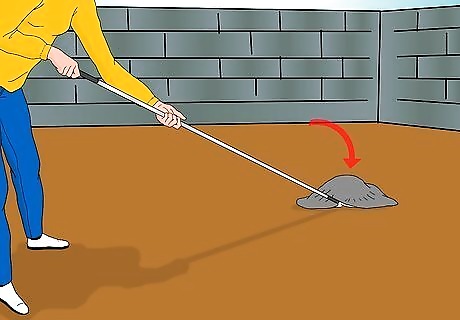
Trap the quail in a net if you don’t have a blanket available. Get a good bird catching net that is larger than the quail. Swing the net down on top of the quail to trap it. Keep the net pinned firmly against the ground until you pick up the quail. Moving or sliding the net may injure the bird. Nets are sold online and at some pet and farm supply stores. If you can’t find a net specifically for birds, a bug or fish catching net works well too.
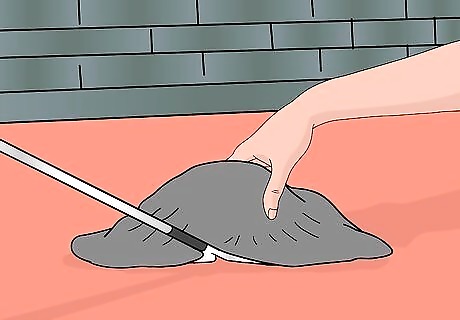
Pick up the quail without removing the cover or net. Gently hold onto the quail’s body. Keep its wings pinned down as much as possible. If you caught the quail in a blanket, keep it wrapped up to avoid any risk of it escaping. If you used a net, lift the net as you hold the quail with your other hand. Get a good grip on the quail before trying to move it. Quail are fast, so make sure you have a firm hold on the bird. If you try lifting the net or cover before grabbing the quail, expect it to take off before you have a chance to react.

Take the quail back to its cage in a small box. The box doesn’t have to be very big. If you have a plastic carrier the quail can’t escape from, stow it in there while you move it. Take some time to inspect the quail’s home for gaps. Repair the damage so the quail can’t escape again. Using a box ensures the quail can’t run off if you lose hold of it. It also gives you an opportunity to inspect the quail’s housing for escape routes. Make sure any box or carrier you use has holes to let in air. Move the quail back into its housing as soon as possible.
Catching Quail Chicks
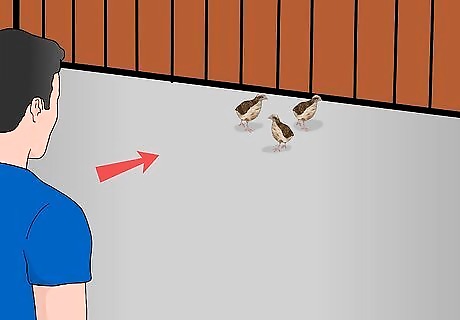
Find out where the quail chicks are. Though chicks are small, they aren’t as difficult to locate as adult quail. They aren’t quite as fast and can’t fly off on you. You may even get to hear the tiny birds peeping as if to show you where they are. Look around hidden areas, such as near bushes, fences, and furniture. Many chicks instinctively head for cover in order to protect themselves from danger.

Try to catch the quail with your hands. Quail chicks may be small, but they can still move fast enough to escape your grasp. Sneak up on them if you can. Moving slowly and quietly reduces the chances of the quail running away. When you get close enough, cup the chicks between your hands. If you are unable to get ahold of the chick, try using a bird catching net. Be gentle. Avoid squeezing quail chicks. They are delicate, so using too much force leads to injuries.

Lure the chick into a pet carrier if you can’t catch it by hand. Choose a pet carrier big enough to hold an adult quail. Check the wiring on the pet carrier to make sure the chick can squeeze through it. Then, place the mother quail inside the carrier. Place the carrier near the chick so the mother calls to it. Get a carrier with the bars set about ⁄2 in (1.3 cm) apart so the adult quail can’t escape. Once the chick enters the cage, cover the opening with a book or another object. Remember, the chick can walk back out whenever it feels like doing so! This strategy works only if you have the chick’s mother. If you don’t have the mother, keep trying to catch it by hand or with a net.

Take the quail back to its home. Carry the chick home, placing it in a box or wire cage if you need to. Inspect the chick’s housing for holes and other signs of damage. Repair these spots before putting the chick back. Also, put back the mother quail if you needed her help to bring back the chick. Chicks belong either in brooders or indoor cages with the mother hen. Place the quail in a safe, warm space to keep them healthy.
Preventing Quail from Escaping
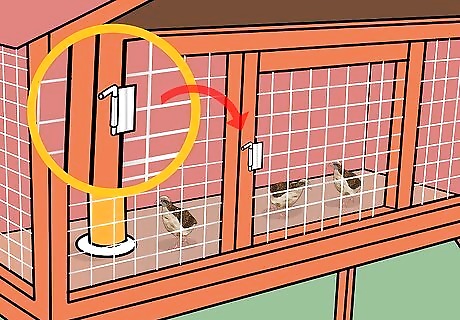
Test the cage or pen door to make sure it shuts properly. The cage door needs to snap closed. If it isn’t tight against the cage, it will leave a gap for the quail to squeeze out of. For additional security, attach a lock to the door. If you live with other people, create rules covering who can open the cage door. Instruct children to ask for permission before letting the quail out.
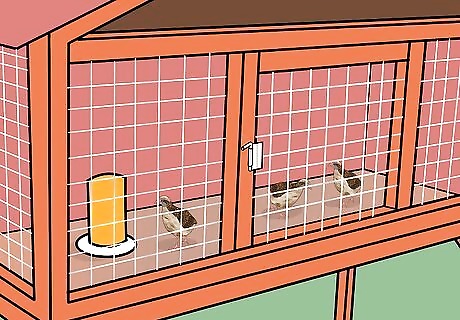
Find holes, gaps, and other weaknesses in the cage. Invest in a better cage or fix the old cage up a little. The wiring on the cage must leave gaps no wider than ⁄2 in (1.3 cm) in size or else the quail will squeeze out. If you find damaged spots, cover them with new pieces of wood or chicken wire. Broken cages also leave your birds vulnerable to predators. Keep the top and bottom portions of quail cages and pens covered to make hunting harder for larger animals.

Place the quail cage in a secure area to prevent escape attempts. Set the quail enclosure apart from any other pets you keep. Close the door and windows if the quail are indoors. When quail are calm, they are less likely to attempt escapes. A peaceful environment is also good for your bird’s health. For indoor birds, choose an area with low traffic such as your bedroom. When a quail escapes, all you have to do is shut the door to restrict its movement. Barns, sheds, and garages are some areas for “outdoor” quail. The birds aren’t technically outside, so you still have the opportunity to lock them in if they escape the cage. For truly outdoor quail, place the cage in an enclosed area. Many quail keepers build chicken runs. Install chicken wire to prevent the quail from wandering off.

Clip your quail’s wings to stop it from flying. If your quail happens to escape, it won’t be able to take to the sky. Take the quail to a vet or groomer for safe clipping. They spread the quail’s wings out and trim the longest feathers with a sharp pair of scissors. It doesn’t hurt, but it limits the bird's ability to fly. You can also do this yourself. Have someone else hold the quail and spread out its wings. Cut the longer feathers by about 0.39 in (0.99 cm). Improper clipping may affect the quail’s balance or lead to irritated feathers. To avoid this risk, always go to a professional.











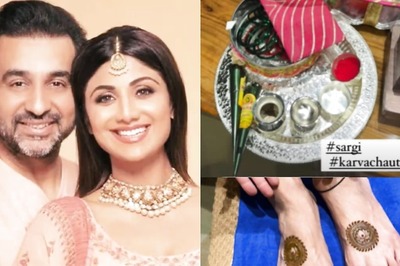
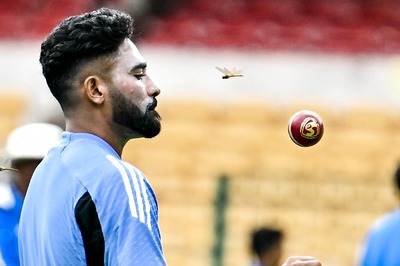







Comments
0 comment